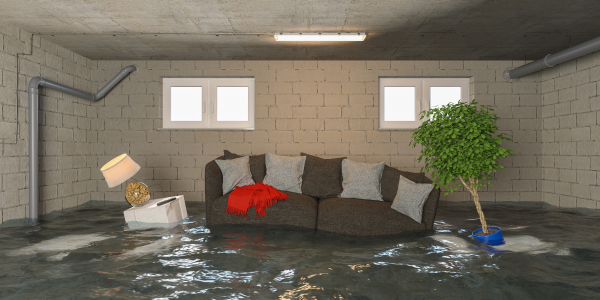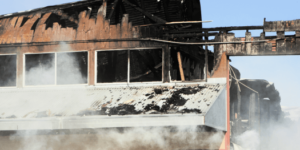
A home is most vulnerable to water damage when the homeowners are away at work, shopping, visiting friends and family, or on vacation.
If the washing machine supply line springs a leak, the results are manageable if the water release is immediately discovered.
However, if the residence is vacant for several days or weeks, the flooding can be disastrous.
Imagine water pouring into a home for days. A burst water pipe can flood a home with seven gallons of water per minute or over ten thousand gallons per day. After a day, the entire house may be affected. If the leak is on the second floor, the devastation is doubled.
Unfortunately, this situation is common. The second most common insurance claim is for a water damage disaster.
The home is filled with numerous potential leak points, including:
- Leaky water heater
- Dripping supply lines to the icemaker, water filter, faucets, and toilets
- Ruptured washing machine hoses
- Burst water pipes in the crawl space or ceiling
- HVAC condensate drain pan issues
Opportunities for a water damage disaster abound. However, by implementing several simple steps, catastrophic water damage can be avoided.
Massive water damage disaster affecting 45 units >>>
Here’s a few tips
1. Regularly install new supply lines to major appliances.
Upgrade supply lines to braided stainless steel. The ice maker and dishwasher should also be inspected. A twenty-dollar upgrade can prevent a twenty-thousand-dollar water damage disaster.
2. Conduct a thorough inspection a week before departure.
Before departure, closely inspect the home for any leaks. A last-minute inspection may uncover a small problem that would’ve gotten much worse. Here are some potential leak points to inspect:
- Feel and look at the valves and pipes under the kitchen and bathroom sinks.
- Check the water heater for cracks, rust, and leaks around the base. Make sure the leak pan drain is secure and unclogged.
- Inspect windows and doors for signs of any leaks.
- Inspect the attic for roof leaks. Look for water stains on the ceiling and for bubbling paint.
3. Shut off the main water valve for total peace of mind.
Make sure the water is off by checking the faucet. The homeowner should be certain that the power to the water heater is off.
If the water valve cannot be turned off due to a sprinkler system, then close the valves at the supply lines to faucets, toilets, and appliances. The additional peace of mind is worth the inconvenience.
4. Make sure gutters are up to par.
A heavy thunderstorm can overtax gutters. Shingle granules, leaves, twigs, and mud can significantly reduce the gutters’ capacity to transport rain to the downspouts, where the water is directed away from the foundation.
Clogged rain gutters and downspouts can result in the eaves and attic being flooded.
Water stains and wavy sheetrock may indicate that the gutters are clogged.
A musty smell may ultimately be linked to a gutter issue. There could be a mold problem developing. Although, water damage doesn’t always lead to a mold issue.
Are water leaks always accompanied by mold? >>>
This matter needs to be resolved before leaving on the month-long Alaskan cruise or the family trip across the United States.
Severe water damage and a mold infestation may greet the returning vacationers if the gutters are not functioning at full capacity.
5. Have a family member or friend walk through the home.
Having a trusted friend, family member, or neighbor perform a scheduled walk-through of the house is a great idea.
Any water intrusion issues that are discovered can be resolved, and a plumber can be called in if needed.
People are taking vacations after being cooped up due to pandemic restrictions. By following a few simple tips, vacationers can get away from it all without worrying about a water damage disaster in the home.
For more information about flood restoration services call their office at (512) 934-8180 or email info@allnationrestoration.com







